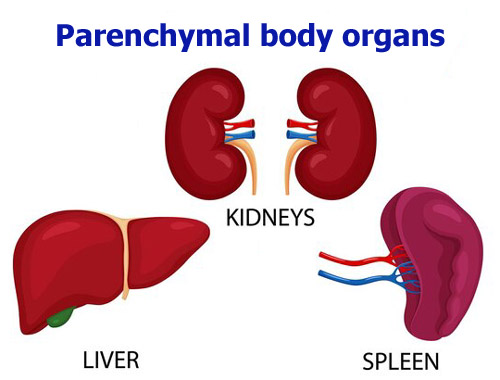Parenchymal Disease

Published: 18 Jun 2025
ICD9: 518.89 ICD10: J84.9 ICD11: XH1S48
Parenchymal disease refers to a disease that affects the functional tissues (parenchyma) of an organ.
The parenchyma is the essential part of an organ that performs its specific functions, as opposed to the supporting structures like connective tissue, blood vessels, and ducts.
Think of it like this:
![]() The Parenchyma is the "workhorse" of the organ. It's the part doing the actual job.
The Parenchyma is the "workhorse" of the organ. It's the part doing the actual job.
![]() Parenchymal disease damages or impairs the function of that "workhorse".
Parenchymal disease damages or impairs the function of that "workhorse".
Here's a breakdown:
Key Concepts:
![]() Parenchyma: The functional tissue of an organ. Examples include:
Parenchyma: The functional tissue of an organ. Examples include:![]()

![]() Liver: Hepatocytes (liver cells)
Liver: Hepatocytes (liver cells)![]()

![]() Lungs: Alveoli (air sacs)
Lungs: Alveoli (air sacs)![]()

![]() Kidneys: Nephrons (filtering units)
Kidneys: Nephrons (filtering units)![]()

![]() Brain: Neurons (nerve cells)
Brain: Neurons (nerve cells)![]()

![]() Thyroid: Follicular cells (hormone-producing cells)
Thyroid: Follicular cells (hormone-producing cells)
![]() Stroma: The supporting tissue of an organ (connective tissue, blood vessels, ducts).
Stroma: The supporting tissue of an organ (connective tissue, blood vessels, ducts).
What happens in Parenchymal Disease?
The parenchyma is damaged or dysfunctional, leading to impaired organ function. This can happen due to:
![]() Inflammation: Caused by infections, autoimmune diseases, or other factors.
Inflammation: Caused by infections, autoimmune diseases, or other factors.
![]() Infection: Viruses, bacteria, or fungi directly damaging the cells.
Infection: Viruses, bacteria, or fungi directly damaging the cells.
![]() Injury: Trauma or exposure to toxins.
Injury: Trauma or exposure to toxins.
![]() Genetic factors: Inherited conditions affecting cell function.
Genetic factors: Inherited conditions affecting cell function.
![]() Circulatory problems: Reduced blood flow causing cell death.
Circulatory problems: Reduced blood flow causing cell death.
![]() Cancer: Tumors arising from parenchymal cells.
Cancer: Tumors arising from parenchymal cells.
![]() Deposits: Abnormal build up of materials (e.g., amyloidosis).
Deposits: Abnormal build up of materials (e.g., amyloidosis).
![]() Fibrosis: Scarring of the tissue, impairing function.
Fibrosis: Scarring of the tissue, impairing function.
Examples of Parenchymal Diseases:
![]() Liver:
Liver:![]()

![]() Hepatitis (inflammation of the liver, often viral)
Hepatitis (inflammation of the liver, often viral)![]()

![]() Cirrhosis (scarring of the liver)
Cirrhosis (scarring of the liver)![]()

![]() Fatty liver disease (accumulation of fat in the liver)
Fatty liver disease (accumulation of fat in the liver)
![]() Lungs:
Lungs:![]()

![]() Pneumonia (infection of the lungs)
Pneumonia (infection of the lungs)![]()

![]() Pulmonary fibrosis (scarring of the lungs)
Pulmonary fibrosis (scarring of the lungs)![]()

![]() Interstitial lung disease (a group of lung diseases affecting the tissue around the air sacs)
Interstitial lung disease (a group of lung diseases affecting the tissue around the air sacs)
![]() Kidneys:
Kidneys:![]()

![]() Glomerulonephritis (inflammation of the kidney's filtering units)
Glomerulonephritis (inflammation of the kidney's filtering units)![]()

![]() Acute tubular necrosis (damage to the kidney tubules)
Acute tubular necrosis (damage to the kidney tubules)
![]() Brain:
Brain:![]()

![]() Alzheimer's disease (neurodegeneration)
Alzheimer's disease (neurodegeneration)![]()

![]() Stroke (damage due to lack of blood flow)
Stroke (damage due to lack of blood flow)![]()

![]() Encephalitis (inflammation of the brain)
Encephalitis (inflammation of the brain)
![]() Thyroid:
Thyroid:![]()

![]() Hashimoto's thyroiditis (autoimmune destruction of thyroid cells)
Hashimoto's thyroiditis (autoimmune destruction of thyroid cells)
Diagnosis:
Diagnosis of parenchymal disease typically involves:
![]() Medical history and physical examination: To assess symptoms and risk factors.
Medical history and physical examination: To assess symptoms and risk factors.
![]() Blood tests: To evaluate organ function and detect inflammation or infection.
Blood tests: To evaluate organ function and detect inflammation or infection.
![]() Imaging studies:
Imaging studies:![]()

![]() X-rays, CT scans, MRIs, and ultrasounds: To visualize the organ and identify abnormalities.
X-rays, CT scans, MRIs, and ultrasounds: To visualize the organ and identify abnormalities.
![]() Biopsy: To obtain a tissue sample for microscopic examination.
Biopsy: To obtain a tissue sample for microscopic examination.
Treatment:
Treatment depends on the specific organ affected, the cause of the disease, and the severity of the condition. Possible treatments include:
![]() Medications: To treat infections, reduce inflammation, suppress the immune system, or manage symptoms.
Medications: To treat infections, reduce inflammation, suppress the immune system, or manage symptoms.
![]() Lifestyle changes: Such as diet, exercise, and smoking cessation.
Lifestyle changes: Such as diet, exercise, and smoking cessation.
![]() Surgery: To remove tumors, repair damage, or transplant the organ.
Surgery: To remove tumors, repair damage, or transplant the organ.
![]() Supportive care: To manage symptoms and improve quality of life.
Supportive care: To manage symptoms and improve quality of life.
In summary, parenchymal disease is any condition that affects the functional tissues of an organ, leading to impaired organ function. Understanding the specific organ involved and the underlying cause is crucial for accurate diagnosis and effective treatment.